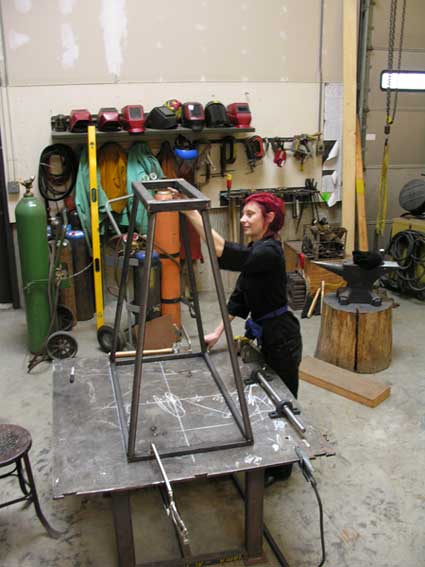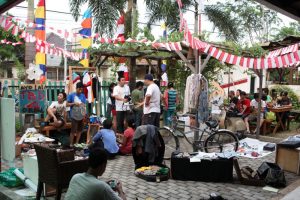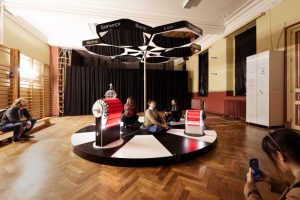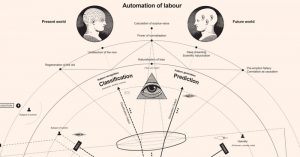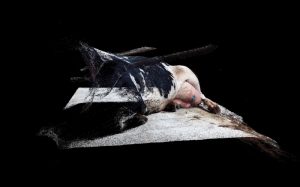Reading the lovely blog of Cati Vaucelle, i discovered the work of Kate James. Kate is a second year graduate student in the Visual Arts Program at MIT. After having studied dance/kinesthesia and architectural history at Brown University, she did a Master of Architecture at MIT before transferring into the Visual Arts program.
Her design, fashion, performative, video and space projects focus on the body, its habits, movements, and the dynamic sectional relationship to its surrounding structures. They have this wonderful mix of quirkiness and deep relevance to the issues she investigates.
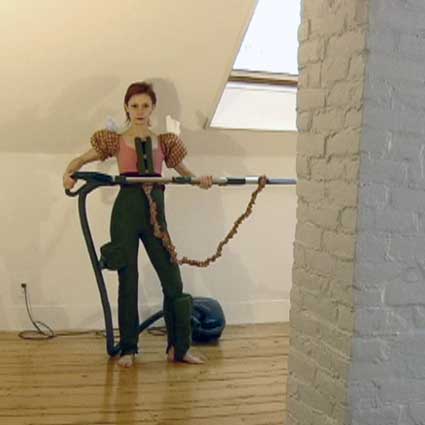 You have a background in both dance/choreography and architecture. How does your knowledge of the body and its dynamics feeds your thoughts and creativity in architecture? How do you make these two seemingly different fields meet?
You have a background in both dance/choreography and architecture. How does your knowledge of the body and its dynamics feeds your thoughts and creativity in architecture? How do you make these two seemingly different fields meet?
I started studying dance and architecture at the same time, during my first year as an undergraduate. Maybe because of that, my understanding of architecture has always been rooted in the body. I think of architecture as a built echo of body itself: corporeal issues of public/ private, structural systems, skins, orifice and interface all resound in architecture.
Now, I often site my art practice between the body and its surrounding structures. This dynamic negative space houses habitual life and cultural inscription, and is therefore subject to interrogation through artistic intervention.
Your MIT page says that your work attempts to “question and complicate the interfaces between the corporeal and the environmental”. In a time when most designers talk about “making it simple”, why do you think it is important to “complicate”? Which form does this complication take?
I guess by ‘complicate’ I mean to acknowledge and engage with the complexity of the interfaces already in play. We so easily naturalize our interactions and surroundings, ignoring the layers of choreography imposed on the everyday. By tweaking and reframing the everyday relations between the body and its environment, my work refutes the source and nature of that everyday ritual.
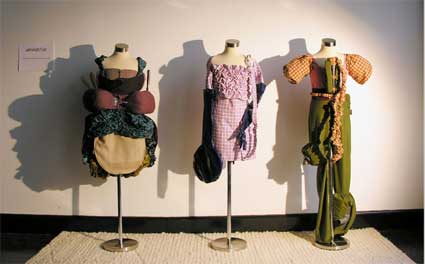 I was very intrigued by the atHABITat costumes. There is one for vacuuming, one for serving food and a third one for putting away the dishes.
I was very intrigued by the atHABITat costumes. There is one for vacuuming, one for serving food and a third one for putting away the dishes.
What was the inspiration for them?
Can you describe us what they are about and how each of them should be used?
The atHABITat costumes are about a contemporary vision of the woman in the home, and a need to multi-task and overlap the upkeep habits of the body and the home. They are costumes worn to augment the household maintenance task, transforming it into an iso-kinetic exercise. Each costume records and accentuates the ergonomics of the activity.
In one, resistance band connects the vacuum wand to the wearer, intensifying the sweeping motion of the vacuuming. The ‘putting away dishes’ costume attaches a similar resistance band between the dishwasher and the wearer’s vinyl gloves. In the ‘serving food’ costume, bands run through an oven mitt corset piece to accentuate the tension in the serving motion.
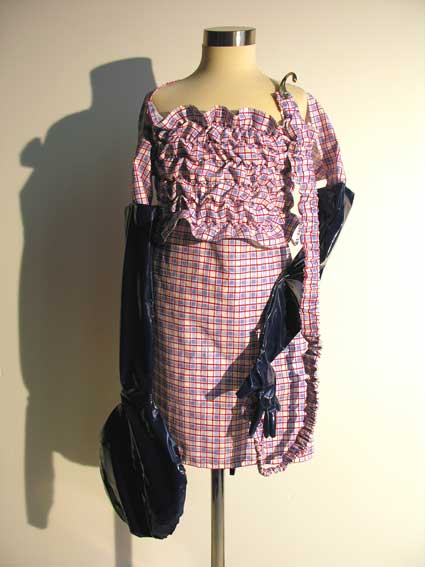 Once you have an idea for a project how do you push it forward and bring it to life? Do you test the idea on other people? Ask for feedbacks? Get depressed because it is technologically impossible to prototype it? What is the path that leads from idea to working prototype?
Once you have an idea for a project how do you push it forward and bring it to life? Do you test the idea on other people? Ask for feedbacks? Get depressed because it is technologically impossible to prototype it? What is the path that leads from idea to working prototype?
I would say the process goes like this: dream, doodle, make, discuss, research, make more, research more, discuss, display.
In terms of the making, I’m not a pre-planning type. I design and make things in one fluid mess of a step, whether this involves sewing, welding, or performing. The concept and research frame are usually fixed, but the work formally develops in an organic way as it goes along.
My biggest frustration is usually the scope of the projects compared to my personal capabilities. Because my work is very much about self-production, and because of the flow of my design process, I am committed to be involved with the craft and production of my costumes and props. But this production can involve 200 pounds of steel to weld or 60 hours of hand-sewing on a particular project.
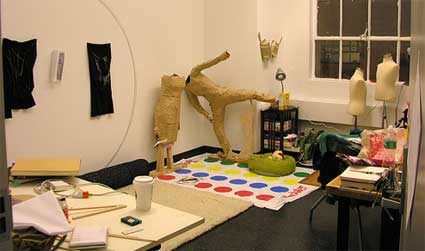 Kate’s working space
Kate’s working space
The garments you create are very well-designed. But do they function purely as accessories for performances or could you imagine everyday people wearing a modified version of them?
When I make costumes, they aren’t intended as prototypes for products. They are very individuated, for one thing, designed specifically for my own home and body(both formally and functionally).
The costumes are an integral part of my performance practice. They are there to suggest that there is a latent potential for self-production in the scene of the everyday, and to transform actions into performances.
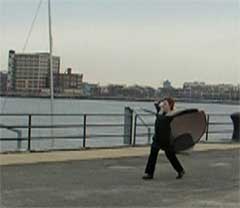 What was the inspiration for Dressails?
What was the inspiration for Dressails?
As a dancer, I was fascinated with falling. I studied how to fall, and tested gravity all the time.
I also sailed a lot when I was younger. I was terrified of, and in love with, especially strong winds that would tip the boat up on its edge and press hard on the sail.
I thought about this moment of negotiation between the control of the boat and the natural force of the wind. I wanted to give over some control of my body’s movements to the wind in the same way, and used clothing design to achieve that. The dresses cause the wearer’s body to teeter, spin, and lean, to be engaged with a natural and sporadic force a way that wouldn’t be possible otherwise.
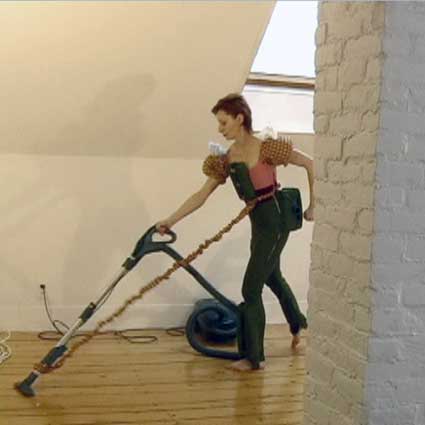 Could you tell us about some of your recent projects?
Could you tell us about some of your recent projects?
One thing I’m working on in an ongoing way is a series of videos about my (7) vacuum cleaners. One piece involves assessing the manual instruction versus reality of use. Another documents a normal vacuuming session that turns into a full-on wrestling bout with the machine.
I also made some wearable trampolines last year, and performed with them in a piece called ‘Six Corners’. There is a dynamic relationship between the body and the material and weight of the skirts. They are meant to discuss movement pattern, issues of personal boundaries, and body extension.
 Which artists or designer do you find most inspiring and why?
Which artists or designer do you find most inspiring and why?
Artists whose work I look most often at include Rebecca Horn, Martha Rosler, Bruce Nauman, Miranda July, Joan Jonas (who is my thesis advisor, which is an amazing privilege), Nina Yuen.
More and more I find myself looking at dancers/ choreographers who make art, especially Trisha Brown, Yvonne Rainer, Ann Carlson.
I look at screen stars as well, those who use their bodies to tell stories: Lucille Ball, Charlie Chaplin, Buster Keaton, the cast of Three’s Company.
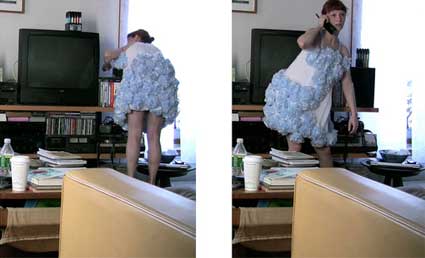 Any upcoming projects you could share with us?
Any upcoming projects you could share with us?
I’m working on a project right now in conjunction with my thesis (titled ‘homebody’). I’m making more home maintenance costumes and associated performances. So far, I’ve made a video of a phone conversation I had with my mortgage agent while wearing/using a dress constructed of Swiffer rosettes.
A last one: what is your relationship with fashion?
As an artist, I certainly engage with fashion. By this I mean that I think closely about how the body is clad, and how clothing can inform the body and vice-versa. Fashion becomes a key interface in the investigation of the body in the environment.
In terms of performance and the impact of costuming, fashion offers a fantastic bank of codified aesthetics, which can be drawn from for conceptual and phenomenal meaning.
Thanks Katherine!
